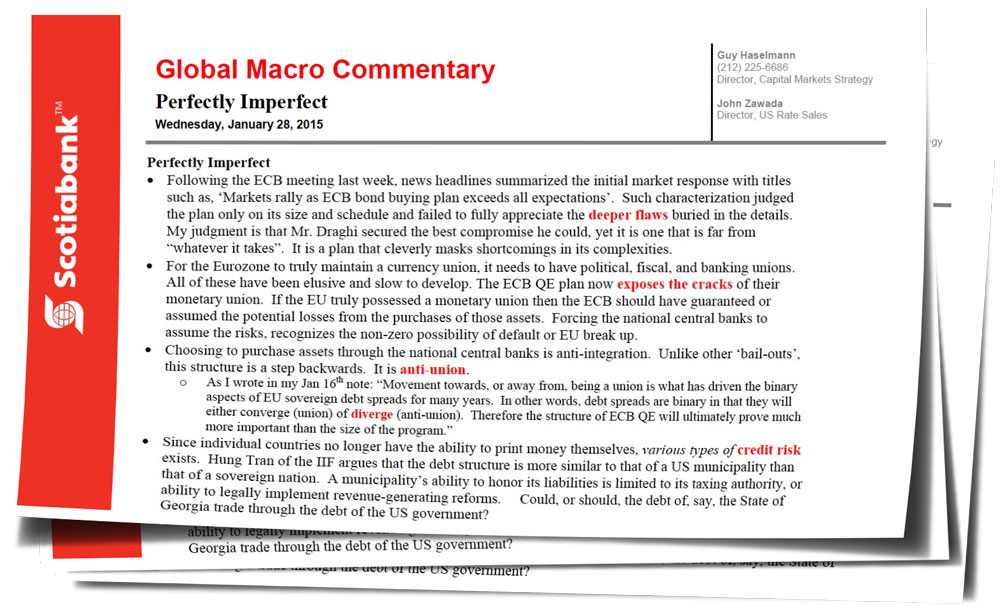Perfectly Imperfect
by Guy Haselmann, Director, Capital Markets Strategy, Scotiabank GBM
· Following the ECB meeting last week, news headlines summarized the initial market response with titles such as, ‘Markets rally as ECB bond buying plan exceeds all expectations’. Such characterization judged the plan only on its size and schedule and failed to fully appreciate the deeper flaws buried in the details. My judgment is that Mr. Draghi secured the best compromise he could, yet it is one that is far from “whatever it takes”. It is a plan that cleverly masks shortcomings in its complexities.
· For the Eurozone to truly maintain a currency union, it needs to have political, fiscal, and banking unions. All of these have been elusive and slow to develop. The ECB QE plan now exposes the cracks of their monetary union. If the EU truly possessed a monetary union then the ECB should have guaranteed or assumed the potential losses from the purchases of those assets. Forcing the national central banks to assume the risks, recognizes the non-zero possibility of default or EU break up.
· Choosing to purchase assets through the national central banks is anti-integration. Unlike other ‘bail-outs’, this structure is a step backwards. It is anti-union.
o As I wrote in my Jan 16th note: “Movement towards, or away from, being a union is what has driven the binary aspects of EU sovereign debt spreads for many years. In other words, debt spreads are binary in that they will either converge (union) of diverge (anti-union). Therefore the structure of ECB QE will ultimately prove much more important than the size of the program.”
· Since individual countries no longer have the ability to print money themselves, various types of credit risk exists. Hung Tran of the IIF argues that the debt structure is more similar to that of a US municipality than that of a sovereign nation. A municipality’s ability to honor its liabilities is limited to its taxing authority, or ability to legally implement revenue-generating reforms. Could, or should, the debt of, say, the State of Georgia trade through the debt of the US government?
· I point this out since BBB rated Spanish 10-year bonds traded 55 basis points below AAA-rated US 10-year Treasuries (after the ECB announcement). I believe this spread will move during the year from the ‘negative 50 area’ to a spread that is positive by hundreds of basis points. I believe this will be one of the best trades of 2015. (The Spain/Bund spread fell below 100 bps; I obviously expect it to widen significantly as well)
· ECB debt purchases will be made in line with the individual countries’ share of ECB equity, so the benefit to the EU periphery’s debt is restricted. About one-third of all purchases will be in German and French debt. Spain’s equity contribution is only 8%.
· The ECB’s single mandate is to maintain price stability (not to spur economic growth or employment). The plan’s mechanism that helps to achieve such a goal is a weakening of the Euro. The ECB has had great success in this regard over the past 7 months simply by promising a QE program (i.e., Euro from 1.35 to 1.15). The announced program is designed to weaken it further and ‘buy more time’ by hinting at the open-ended nature of the QE program should it not reach its inflation objectives by the end date of September ’16.
· Adding such conditionality is a powerful tool today that maximizes ECB flexibility, while limiting the market’s desire to fight its resolve. However, in reality there are two reasons why it is highly unlikely the program is ever extended beyond the announced end-date of September 2016. If the ECB’s inflation goal has not worked by September of 2016, then it is likely to be viewed as being ineffective, increasing the likelihood that those who were reluctant supporters in the first place will want to abandon it. On the other hand, if the inflation rate begins to creep back up in the ‘preferred direction’, then the ECB would want to end the program and may even wish to do so early.
· The ECB has cleverly set the timetable in a way to almost ensure that it will be successful in terms of improvement on the inflation front by September 2016. The reason is due to the year-over-year effects that the price of oil will have on inflation indicators. The price elasticity of oil makes it likely that oil may bottom near current levels between $40-$50 dollars. Should that occur, oil will stop being a drag on inflation indicators beginning in twelve months’ time.
· The market rate for EUR 5-year inflation beginning in 5 years, initially rose from around 1.55% to 1.80% on the ECB announcement, but quickly reversed back to 1.55%. The 10 year German Bund fell in yield from above 0.50% to below 0.35% and has stayed there. This shows me that fixed income markets remain skeptical of the ability of central banks to lift growth or inflation.
· Demand for money to invest in the real economy does not pick up when unusually low rates are lowered modestly lower, particularly when debt levels are already quite elevated. The plummeting velocity of money is a symptom of extreme indebtedness. Imposing a negative yield of 0.20% on the excess reserves of EU banks is a tax intended to boost lending, but there are many consequences to imposing such financial repression with little evidence that the intended goal will come to fruition.
· Lowering rates from already low levels hurts the lender because margins usually fall as well. Lenders have a disincentive to lend when they believe that their compensation for the loan is inadequate. Moreover, promises that rates will remain low for a period of time damages confidence that economic activity is improving.
· The Fed has boxed itself into a corner as it has attempted to prepare the markets for a rate hike around June. If it does not raise rates in June, or thereabouts, then it must have an exceptionally good reason. The reason would have to be a significant and material deterioration in the economy or a highly troubling worsening of the geopolitical environment.
· Regardless, risk assets are likely to suffer mightily in the near future under either scenario. Risk assets will either have to endure a Fed hike or worsening conditions. The high for the year for the S&P could already be in place. Either way, the biggest beneficiary will remain the back end of the Treasury curve. I remain a bond bull.
· Extreme central bank policies over the past 5 years have ballooned asset prices, fueled speculation and moral hazard, and exhausted interest rate tools of central banks. The Swiss National Bank reminded markets just how fleeting promises can be. And now, central bank’s under-delivering on growth and inflation promises are now further concerning risked-up markets; such could not come at a worse time.
· It appears markets are on the verge of learning just how damaging the unintended consequences will be from multiple years of extreme central bank promises now that the Fed has run out of the ammunition to keep the utopian market façade alive. The structure of the ECB QE and the Greek situation make the backdrop considerably more troubling and difficult.
“Can you tell a green field from a cold steel rail? / A smile from a veil? / Do you think you can tell?” – Pink Floyd
Regards,
Guy
Guy Haselmann | Director, Capital Markets Strategy
▬▬▬▬▬▬▬▬▬▬▬▬▬▬▬▬▬▬▬▬▬▬▬▬▬▬▬
Scotiabank | Global Banking and Markets
250 Vesey Street | New York, NY 10281
T-212.225.6686 | C-917-325-5816
guy.haselmann[at]scotiabank.com
Scotiabank is a business name used by The Bank of Nova Scotia
Read/Download Guy Haselmann's complete note below:
Global Macro Commentary Jan 28
Copyright © Scotiabank GBM














